Comparative Analysis of ERP Systems: Case Studies and Insights
VerifiedAdded on 2021/06/16
|19
|4525
|191
Report
AI Summary
This report provides a comprehensive overview of Enterprise Resource Planning (ERP) systems, comparing on-premise, hosted, and cloud-based solutions. It begins with an introduction to ERP and then delves into the specifics of each system type, outlining their respective advantages and disadvantages. The report includes real-world case studies of Shaw Industries Group and VINSUN Infra Engineering to illustrate the practical implications of ERP implementation. Shaw Industries' experience highlights the benefits of cloud ERP, such as flexibility and cost savings, while VINSUN's case emphasizes the challenges and considerations in adopting new technologies. The analysis covers key aspects like implementation costs, data management, scalability, and the impact on business operations. The report concludes with a summary of the key findings and a comparative analysis of the different ERP systems, offering valuable insights for businesses considering ERP solutions.

Running head: CLOUD ERP SYSTEM
CLOUD ERP SYSTEM
Name of the University
Name of the student
Author Note
CLOUD ERP SYSTEM
Name of the University
Name of the student
Author Note
Paraphrase This Document
Need a fresh take? Get an instant paraphrase of this document with our AI Paraphraser
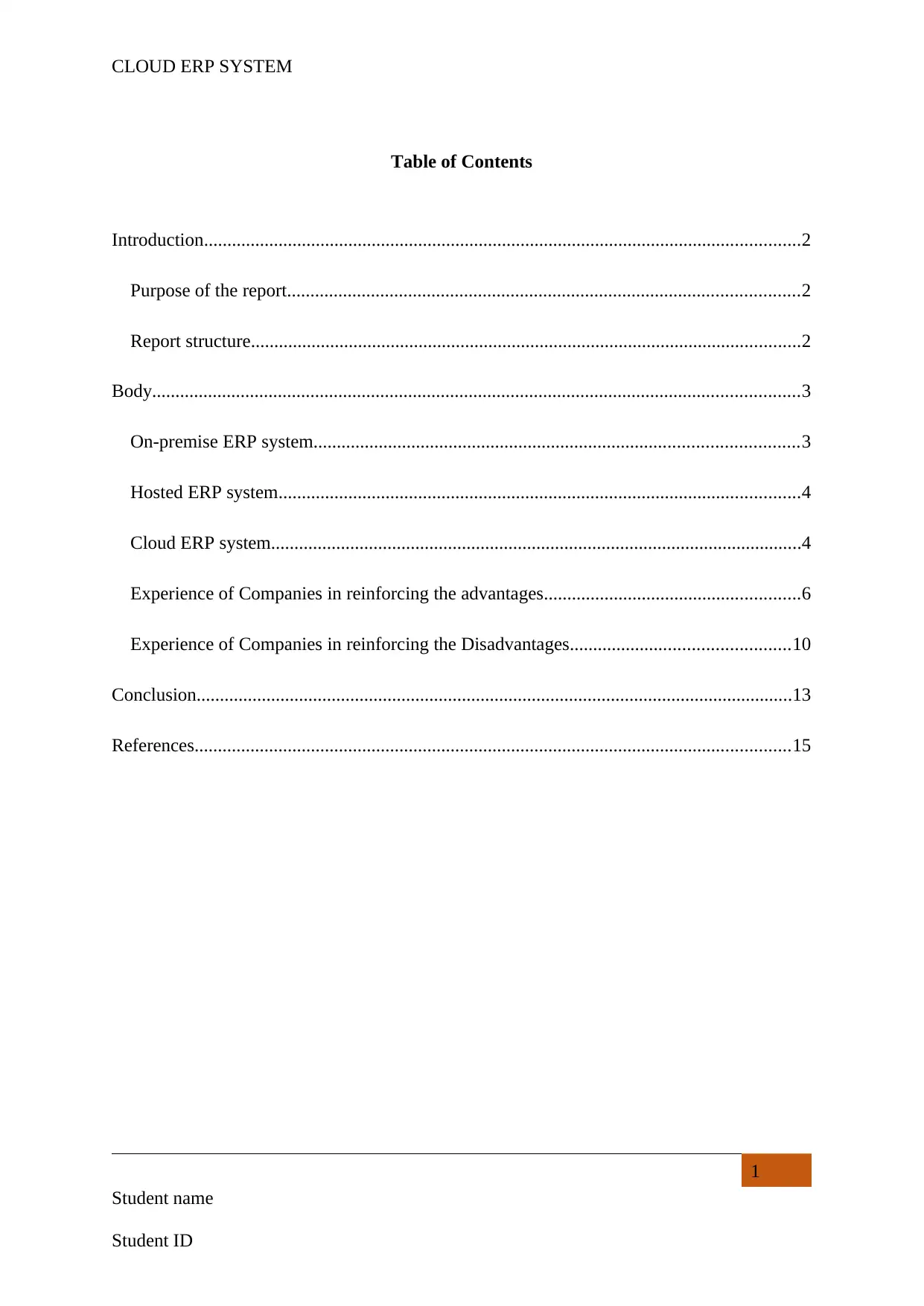
CLOUD ERP SYSTEM
Table of Contents
Introduction................................................................................................................................2
Purpose of the report..............................................................................................................2
Report structure......................................................................................................................2
Body...........................................................................................................................................3
On-premise ERP system........................................................................................................3
Hosted ERP system................................................................................................................4
Cloud ERP system..................................................................................................................4
Experience of Companies in reinforcing the advantages.......................................................6
Experience of Companies in reinforcing the Disadvantages...............................................10
Conclusion................................................................................................................................13
References................................................................................................................................15
1
Student name
Student ID
Table of Contents
Introduction................................................................................................................................2
Purpose of the report..............................................................................................................2
Report structure......................................................................................................................2
Body...........................................................................................................................................3
On-premise ERP system........................................................................................................3
Hosted ERP system................................................................................................................4
Cloud ERP system..................................................................................................................4
Experience of Companies in reinforcing the advantages.......................................................6
Experience of Companies in reinforcing the Disadvantages...............................................10
Conclusion................................................................................................................................13
References................................................................................................................................15
1
Student name
Student ID
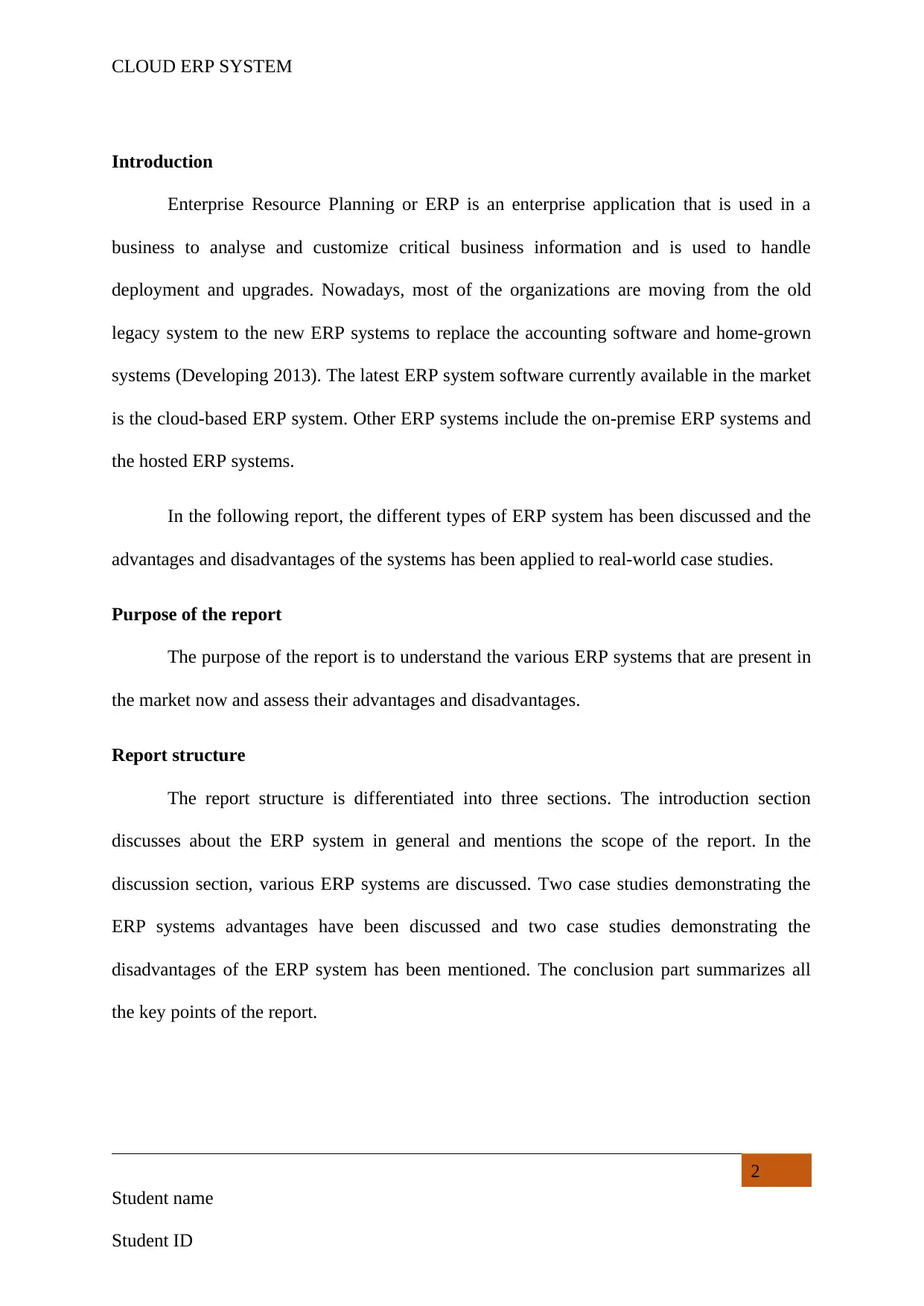
CLOUD ERP SYSTEM
Introduction
Enterprise Resource Planning or ERP is an enterprise application that is used in a
business to analyse and customize critical business information and is used to handle
deployment and upgrades. Nowadays, most of the organizations are moving from the old
legacy system to the new ERP systems to replace the accounting software and home-grown
systems (Developing 2013). The latest ERP system software currently available in the market
is the cloud-based ERP system. Other ERP systems include the on-premise ERP systems and
the hosted ERP systems.
In the following report, the different types of ERP system has been discussed and the
advantages and disadvantages of the systems has been applied to real-world case studies.
Purpose of the report
The purpose of the report is to understand the various ERP systems that are present in
the market now and assess their advantages and disadvantages.
Report structure
The report structure is differentiated into three sections. The introduction section
discusses about the ERP system in general and mentions the scope of the report. In the
discussion section, various ERP systems are discussed. Two case studies demonstrating the
ERP systems advantages have been discussed and two case studies demonstrating the
disadvantages of the ERP system has been mentioned. The conclusion part summarizes all
the key points of the report.
2
Student name
Student ID
Introduction
Enterprise Resource Planning or ERP is an enterprise application that is used in a
business to analyse and customize critical business information and is used to handle
deployment and upgrades. Nowadays, most of the organizations are moving from the old
legacy system to the new ERP systems to replace the accounting software and home-grown
systems (Developing 2013). The latest ERP system software currently available in the market
is the cloud-based ERP system. Other ERP systems include the on-premise ERP systems and
the hosted ERP systems.
In the following report, the different types of ERP system has been discussed and the
advantages and disadvantages of the systems has been applied to real-world case studies.
Purpose of the report
The purpose of the report is to understand the various ERP systems that are present in
the market now and assess their advantages and disadvantages.
Report structure
The report structure is differentiated into three sections. The introduction section
discusses about the ERP system in general and mentions the scope of the report. In the
discussion section, various ERP systems are discussed. Two case studies demonstrating the
ERP systems advantages have been discussed and two case studies demonstrating the
disadvantages of the ERP system has been mentioned. The conclusion part summarizes all
the key points of the report.
2
Student name
Student ID
⊘ This is a preview!⊘
Do you want full access?
Subscribe today to unlock all pages.

Trusted by 1+ million students worldwide
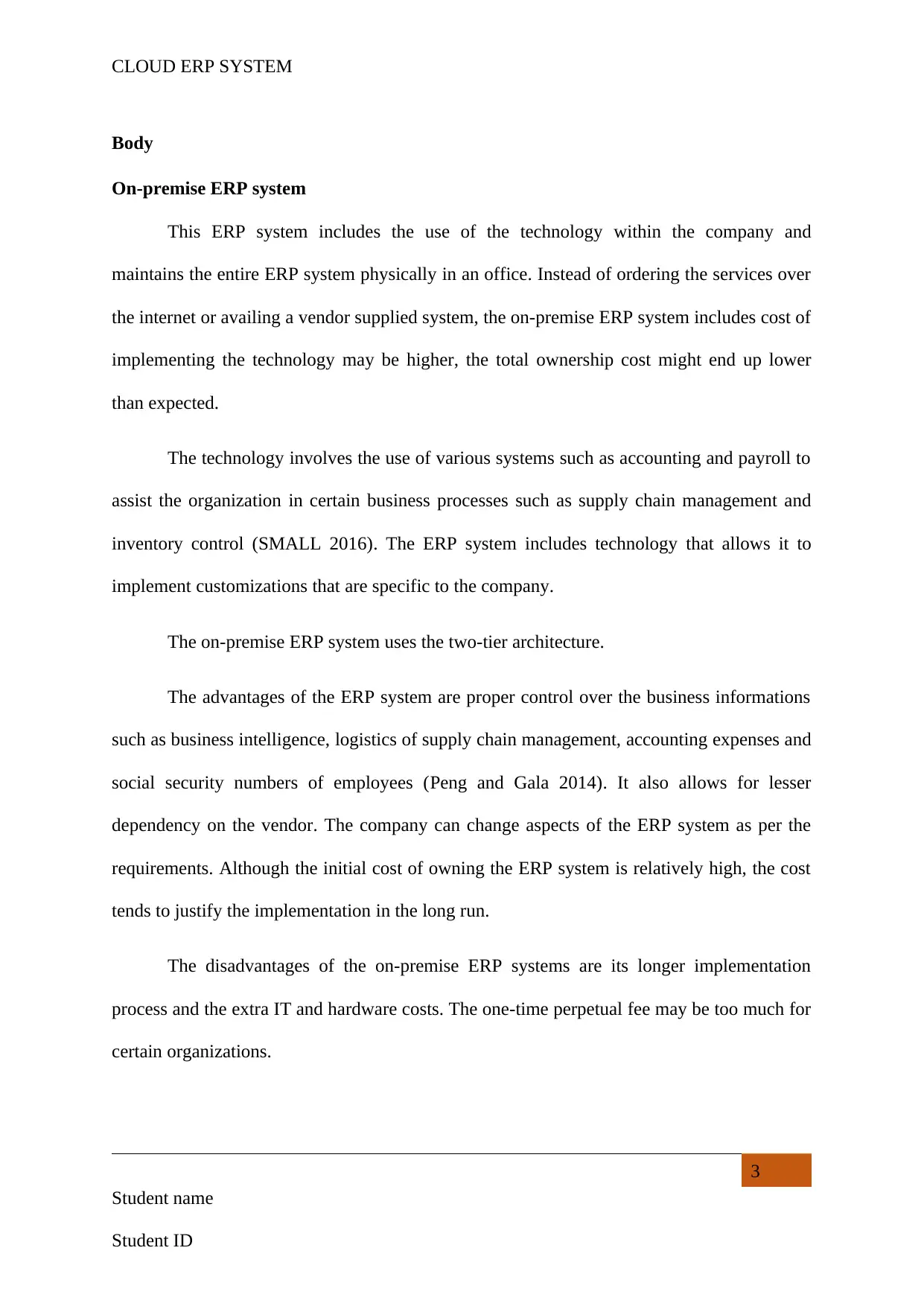
CLOUD ERP SYSTEM
Body
On-premise ERP system
This ERP system includes the use of the technology within the company and
maintains the entire ERP system physically in an office. Instead of ordering the services over
the internet or availing a vendor supplied system, the on-premise ERP system includes cost of
implementing the technology may be higher, the total ownership cost might end up lower
than expected.
The technology involves the use of various systems such as accounting and payroll to
assist the organization in certain business processes such as supply chain management and
inventory control (SMALL 2016). The ERP system includes technology that allows it to
implement customizations that are specific to the company.
The on-premise ERP system uses the two-tier architecture.
The advantages of the ERP system are proper control over the business informations
such as business intelligence, logistics of supply chain management, accounting expenses and
social security numbers of employees (Peng and Gala 2014). It also allows for lesser
dependency on the vendor. The company can change aspects of the ERP system as per the
requirements. Although the initial cost of owning the ERP system is relatively high, the cost
tends to justify the implementation in the long run.
The disadvantages of the on-premise ERP systems are its longer implementation
process and the extra IT and hardware costs. The one-time perpetual fee may be too much for
certain organizations.
3
Student name
Student ID
Body
On-premise ERP system
This ERP system includes the use of the technology within the company and
maintains the entire ERP system physically in an office. Instead of ordering the services over
the internet or availing a vendor supplied system, the on-premise ERP system includes cost of
implementing the technology may be higher, the total ownership cost might end up lower
than expected.
The technology involves the use of various systems such as accounting and payroll to
assist the organization in certain business processes such as supply chain management and
inventory control (SMALL 2016). The ERP system includes technology that allows it to
implement customizations that are specific to the company.
The on-premise ERP system uses the two-tier architecture.
The advantages of the ERP system are proper control over the business informations
such as business intelligence, logistics of supply chain management, accounting expenses and
social security numbers of employees (Peng and Gala 2014). It also allows for lesser
dependency on the vendor. The company can change aspects of the ERP system as per the
requirements. Although the initial cost of owning the ERP system is relatively high, the cost
tends to justify the implementation in the long run.
The disadvantages of the on-premise ERP systems are its longer implementation
process and the extra IT and hardware costs. The one-time perpetual fee may be too much for
certain organizations.
3
Student name
Student ID
Paraphrase This Document
Need a fresh take? Get an instant paraphrase of this document with our AI Paraphraser
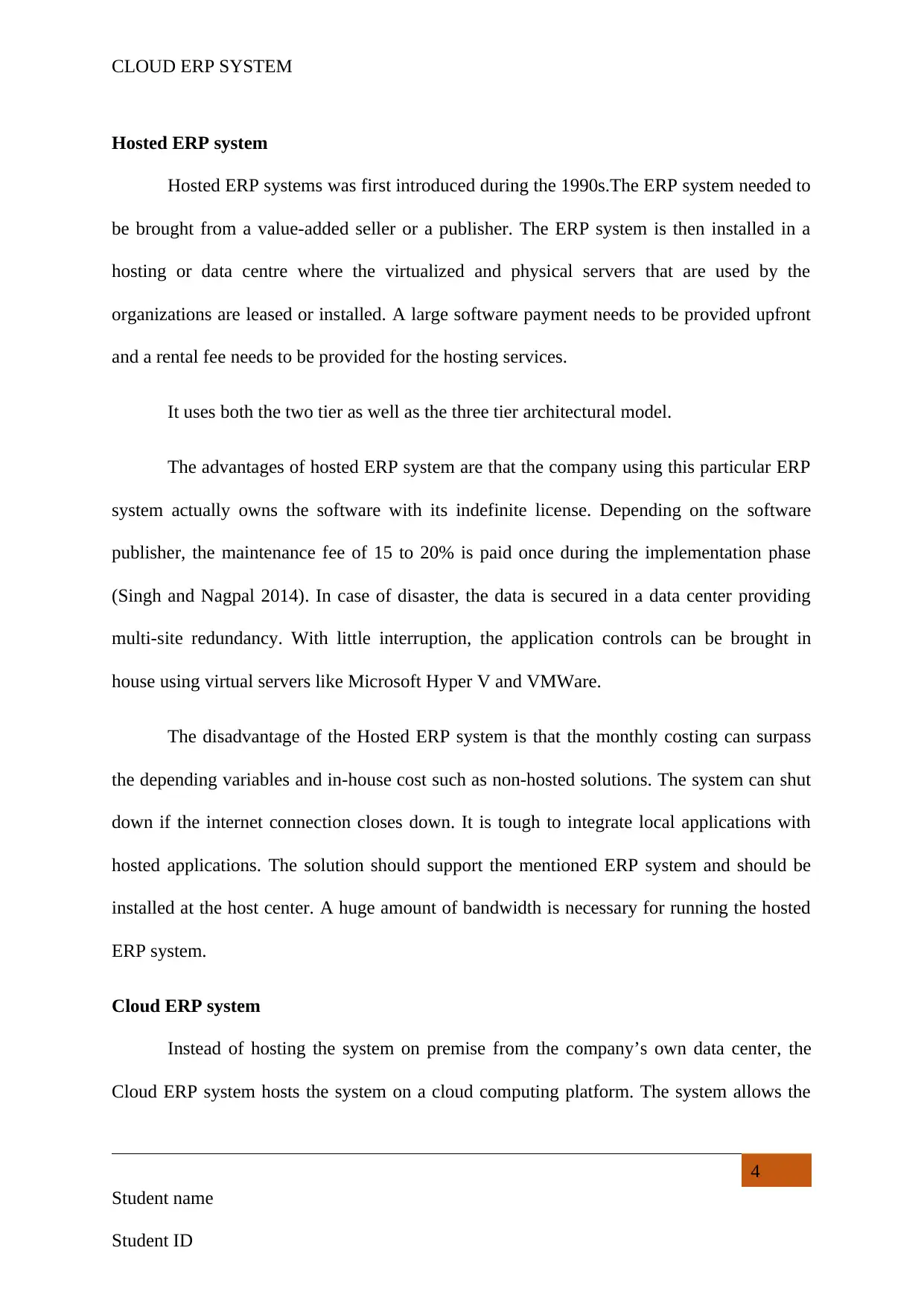
CLOUD ERP SYSTEM
Hosted ERP system
Hosted ERP systems was first introduced during the 1990s.The ERP system needed to
be brought from a value-added seller or a publisher. The ERP system is then installed in a
hosting or data centre where the virtualized and physical servers that are used by the
organizations are leased or installed. A large software payment needs to be provided upfront
and a rental fee needs to be provided for the hosting services.
It uses both the two tier as well as the three tier architectural model.
The advantages of hosted ERP system are that the company using this particular ERP
system actually owns the software with its indefinite license. Depending on the software
publisher, the maintenance fee of 15 to 20% is paid once during the implementation phase
(Singh and Nagpal 2014). In case of disaster, the data is secured in a data center providing
multi-site redundancy. With little interruption, the application controls can be brought in
house using virtual servers like Microsoft Hyper V and VMWare.
The disadvantage of the Hosted ERP system is that the monthly costing can surpass
the depending variables and in-house cost such as non-hosted solutions. The system can shut
down if the internet connection closes down. It is tough to integrate local applications with
hosted applications. The solution should support the mentioned ERP system and should be
installed at the host center. A huge amount of bandwidth is necessary for running the hosted
ERP system.
Cloud ERP system
Instead of hosting the system on premise from the company’s own data center, the
Cloud ERP system hosts the system on a cloud computing platform. The system allows the
4
Student name
Student ID
Hosted ERP system
Hosted ERP systems was first introduced during the 1990s.The ERP system needed to
be brought from a value-added seller or a publisher. The ERP system is then installed in a
hosting or data centre where the virtualized and physical servers that are used by the
organizations are leased or installed. A large software payment needs to be provided upfront
and a rental fee needs to be provided for the hosting services.
It uses both the two tier as well as the three tier architectural model.
The advantages of hosted ERP system are that the company using this particular ERP
system actually owns the software with its indefinite license. Depending on the software
publisher, the maintenance fee of 15 to 20% is paid once during the implementation phase
(Singh and Nagpal 2014). In case of disaster, the data is secured in a data center providing
multi-site redundancy. With little interruption, the application controls can be brought in
house using virtual servers like Microsoft Hyper V and VMWare.
The disadvantage of the Hosted ERP system is that the monthly costing can surpass
the depending variables and in-house cost such as non-hosted solutions. The system can shut
down if the internet connection closes down. It is tough to integrate local applications with
hosted applications. The solution should support the mentioned ERP system and should be
installed at the host center. A huge amount of bandwidth is necessary for running the hosted
ERP system.
Cloud ERP system
Instead of hosting the system on premise from the company’s own data center, the
Cloud ERP system hosts the system on a cloud computing platform. The system allows the
4
Student name
Student ID
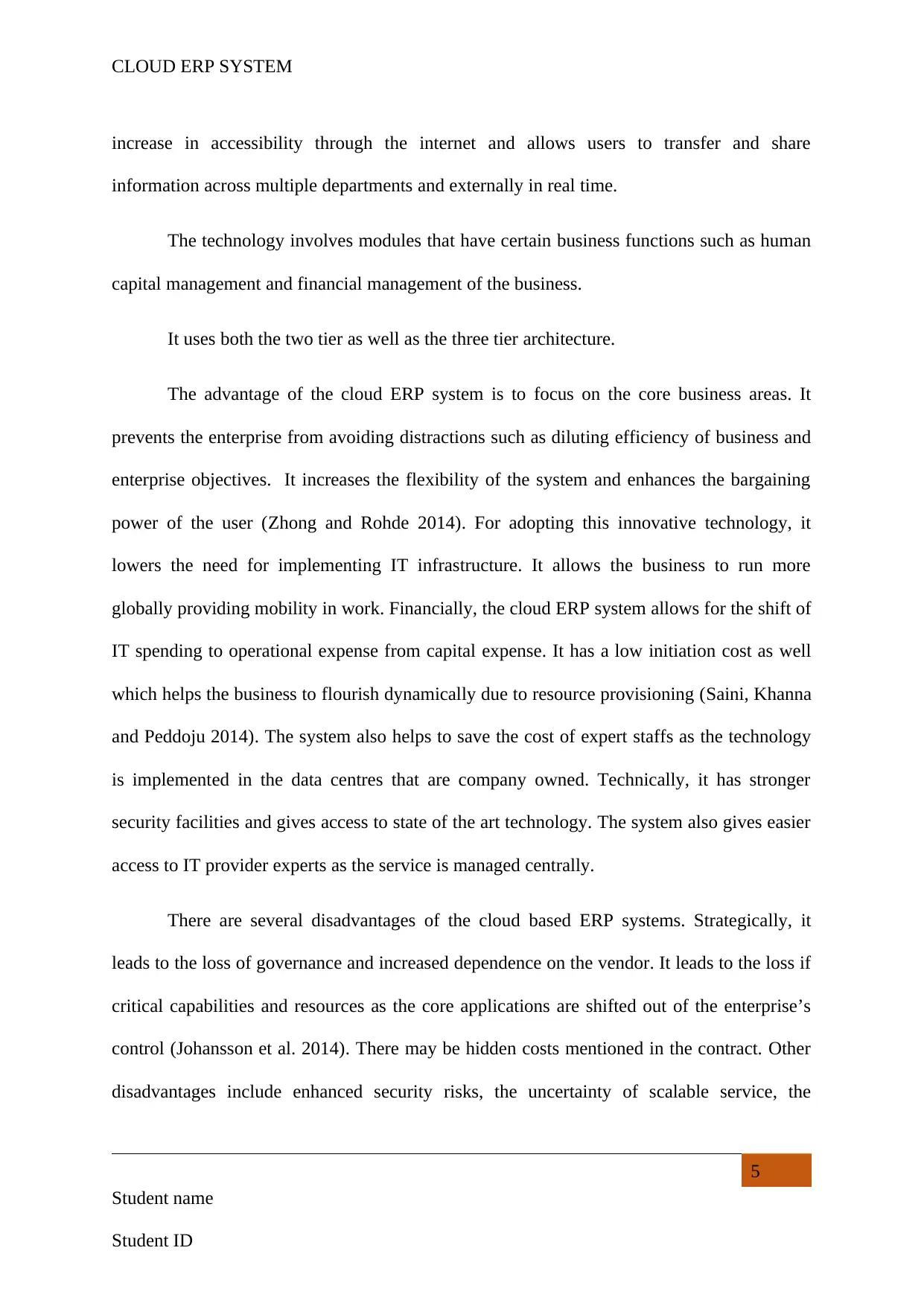
CLOUD ERP SYSTEM
increase in accessibility through the internet and allows users to transfer and share
information across multiple departments and externally in real time.
The technology involves modules that have certain business functions such as human
capital management and financial management of the business.
It uses both the two tier as well as the three tier architecture.
The advantage of the cloud ERP system is to focus on the core business areas. It
prevents the enterprise from avoiding distractions such as diluting efficiency of business and
enterprise objectives. It increases the flexibility of the system and enhances the bargaining
power of the user (Zhong and Rohde 2014). For adopting this innovative technology, it
lowers the need for implementing IT infrastructure. It allows the business to run more
globally providing mobility in work. Financially, the cloud ERP system allows for the shift of
IT spending to operational expense from capital expense. It has a low initiation cost as well
which helps the business to flourish dynamically due to resource provisioning (Saini, Khanna
and Peddoju 2014). The system also helps to save the cost of expert staffs as the technology
is implemented in the data centres that are company owned. Technically, it has stronger
security facilities and gives access to state of the art technology. The system also gives easier
access to IT provider experts as the service is managed centrally.
There are several disadvantages of the cloud based ERP systems. Strategically, it
leads to the loss of governance and increased dependence on the vendor. It leads to the loss if
critical capabilities and resources as the core applications are shifted out of the enterprise’s
control (Johansson et al. 2014). There may be hidden costs mentioned in the contract. Other
disadvantages include enhanced security risks, the uncertainty of scalable service, the
5
Student name
Student ID
increase in accessibility through the internet and allows users to transfer and share
information across multiple departments and externally in real time.
The technology involves modules that have certain business functions such as human
capital management and financial management of the business.
It uses both the two tier as well as the three tier architecture.
The advantage of the cloud ERP system is to focus on the core business areas. It
prevents the enterprise from avoiding distractions such as diluting efficiency of business and
enterprise objectives. It increases the flexibility of the system and enhances the bargaining
power of the user (Zhong and Rohde 2014). For adopting this innovative technology, it
lowers the need for implementing IT infrastructure. It allows the business to run more
globally providing mobility in work. Financially, the cloud ERP system allows for the shift of
IT spending to operational expense from capital expense. It has a low initiation cost as well
which helps the business to flourish dynamically due to resource provisioning (Saini, Khanna
and Peddoju 2014). The system also helps to save the cost of expert staffs as the technology
is implemented in the data centres that are company owned. Technically, it has stronger
security facilities and gives access to state of the art technology. The system also gives easier
access to IT provider experts as the service is managed centrally.
There are several disadvantages of the cloud based ERP systems. Strategically, it
leads to the loss of governance and increased dependence on the vendor. It leads to the loss if
critical capabilities and resources as the core applications are shifted out of the enterprise’s
control (Johansson et al. 2014). There may be hidden costs mentioned in the contract. Other
disadvantages include enhanced security risks, the uncertainty of scalable service, the
5
Student name
Student ID
⊘ This is a preview!⊘
Do you want full access?
Subscribe today to unlock all pages.

Trusted by 1+ million students worldwide
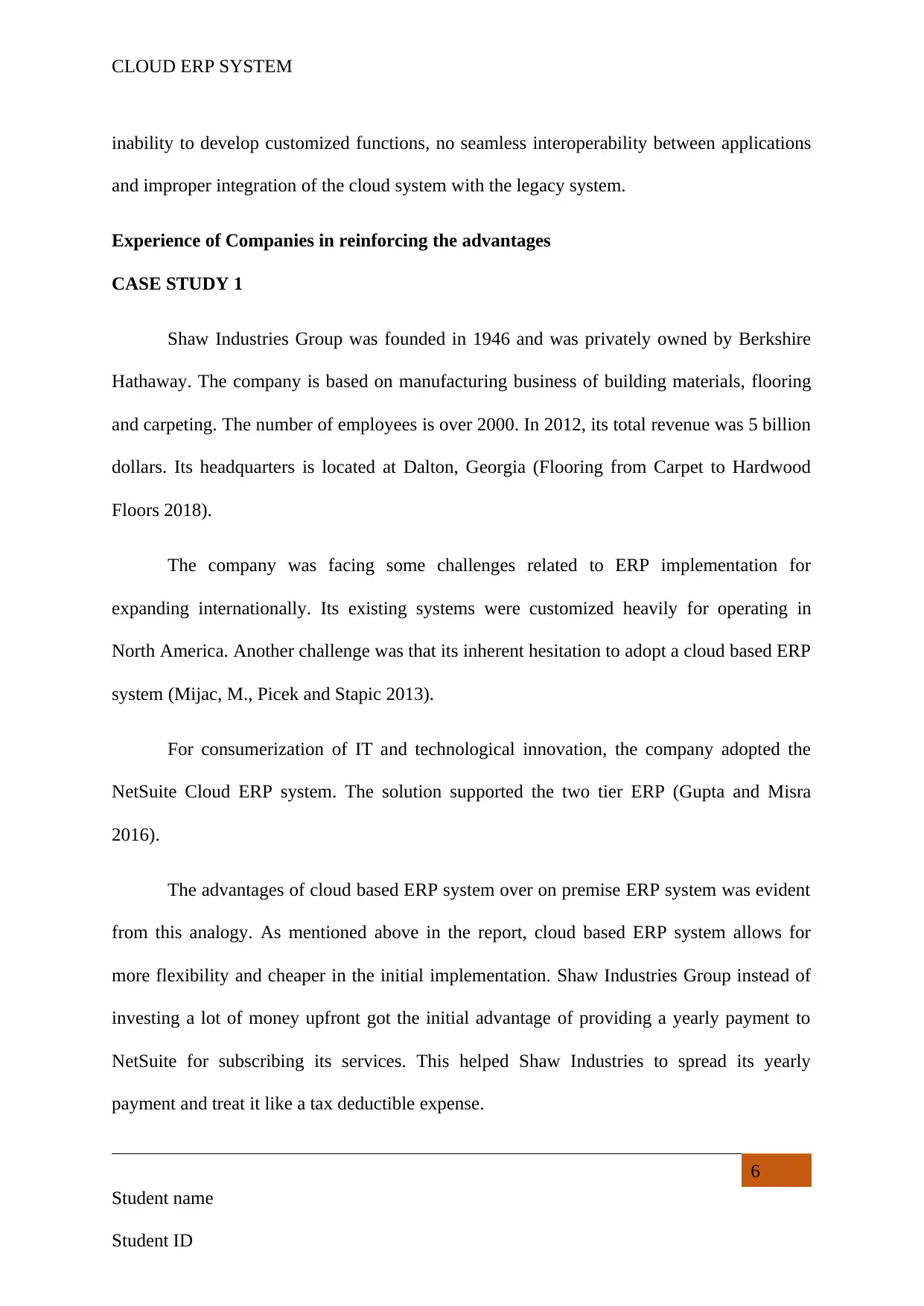
CLOUD ERP SYSTEM
inability to develop customized functions, no seamless interoperability between applications
and improper integration of the cloud system with the legacy system.
Experience of Companies in reinforcing the advantages
CASE STUDY 1
Shaw Industries Group was founded in 1946 and was privately owned by Berkshire
Hathaway. The company is based on manufacturing business of building materials, flooring
and carpeting. The number of employees is over 2000. In 2012, its total revenue was 5 billion
dollars. Its headquarters is located at Dalton, Georgia (Flooring from Carpet to Hardwood
Floors 2018).
The company was facing some challenges related to ERP implementation for
expanding internationally. Its existing systems were customized heavily for operating in
North America. Another challenge was that its inherent hesitation to adopt a cloud based ERP
system (Mijac, M., Picek and Stapic 2013).
For consumerization of IT and technological innovation, the company adopted the
NetSuite Cloud ERP system. The solution supported the two tier ERP (Gupta and Misra
2016).
The advantages of cloud based ERP system over on premise ERP system was evident
from this analogy. As mentioned above in the report, cloud based ERP system allows for
more flexibility and cheaper in the initial implementation. Shaw Industries Group instead of
investing a lot of money upfront got the initial advantage of providing a yearly payment to
NetSuite for subscribing its services. This helped Shaw Industries to spread its yearly
payment and treat it like a tax deductible expense.
6
Student name
Student ID
inability to develop customized functions, no seamless interoperability between applications
and improper integration of the cloud system with the legacy system.
Experience of Companies in reinforcing the advantages
CASE STUDY 1
Shaw Industries Group was founded in 1946 and was privately owned by Berkshire
Hathaway. The company is based on manufacturing business of building materials, flooring
and carpeting. The number of employees is over 2000. In 2012, its total revenue was 5 billion
dollars. Its headquarters is located at Dalton, Georgia (Flooring from Carpet to Hardwood
Floors 2018).
The company was facing some challenges related to ERP implementation for
expanding internationally. Its existing systems were customized heavily for operating in
North America. Another challenge was that its inherent hesitation to adopt a cloud based ERP
system (Mijac, M., Picek and Stapic 2013).
For consumerization of IT and technological innovation, the company adopted the
NetSuite Cloud ERP system. The solution supported the two tier ERP (Gupta and Misra
2016).
The advantages of cloud based ERP system over on premise ERP system was evident
from this analogy. As mentioned above in the report, cloud based ERP system allows for
more flexibility and cheaper in the initial implementation. Shaw Industries Group instead of
investing a lot of money upfront got the initial advantage of providing a yearly payment to
NetSuite for subscribing its services. This helped Shaw Industries to spread its yearly
payment and treat it like a tax deductible expense.
6
Student name
Student ID
Paraphrase This Document
Need a fresh take? Get an instant paraphrase of this document with our AI Paraphraser
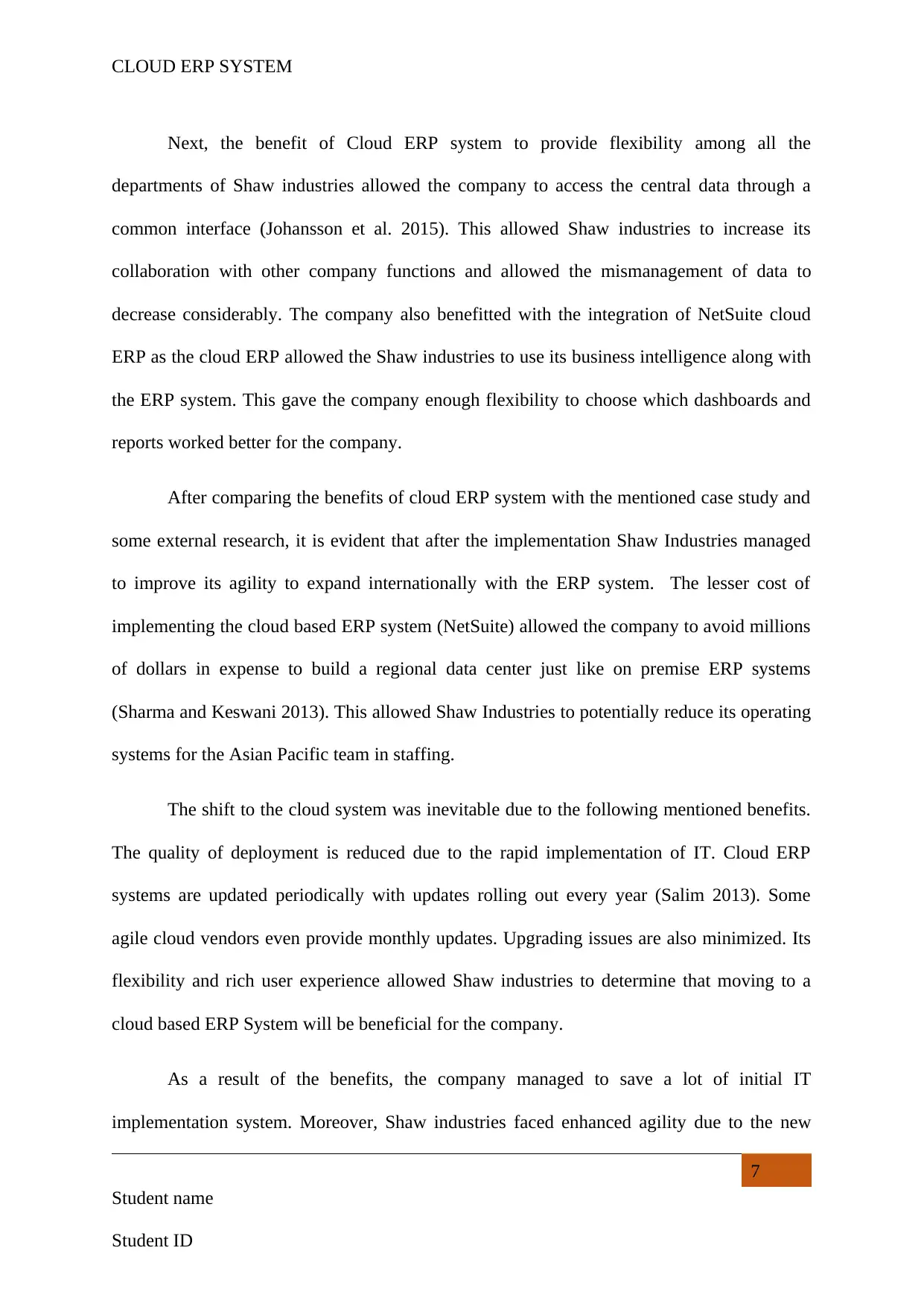
CLOUD ERP SYSTEM
Next, the benefit of Cloud ERP system to provide flexibility among all the
departments of Shaw industries allowed the company to access the central data through a
common interface (Johansson et al. 2015). This allowed Shaw industries to increase its
collaboration with other company functions and allowed the mismanagement of data to
decrease considerably. The company also benefitted with the integration of NetSuite cloud
ERP as the cloud ERP allowed the Shaw industries to use its business intelligence along with
the ERP system. This gave the company enough flexibility to choose which dashboards and
reports worked better for the company.
After comparing the benefits of cloud ERP system with the mentioned case study and
some external research, it is evident that after the implementation Shaw Industries managed
to improve its agility to expand internationally with the ERP system. The lesser cost of
implementing the cloud based ERP system (NetSuite) allowed the company to avoid millions
of dollars in expense to build a regional data center just like on premise ERP systems
(Sharma and Keswani 2013). This allowed Shaw Industries to potentially reduce its operating
systems for the Asian Pacific team in staffing.
The shift to the cloud system was inevitable due to the following mentioned benefits.
The quality of deployment is reduced due to the rapid implementation of IT. Cloud ERP
systems are updated periodically with updates rolling out every year (Salim 2013). Some
agile cloud vendors even provide monthly updates. Upgrading issues are also minimized. Its
flexibility and rich user experience allowed Shaw industries to determine that moving to a
cloud based ERP System will be beneficial for the company.
As a result of the benefits, the company managed to save a lot of initial IT
implementation system. Moreover, Shaw industries faced enhanced agility due to the new
7
Student name
Student ID
Next, the benefit of Cloud ERP system to provide flexibility among all the
departments of Shaw industries allowed the company to access the central data through a
common interface (Johansson et al. 2015). This allowed Shaw industries to increase its
collaboration with other company functions and allowed the mismanagement of data to
decrease considerably. The company also benefitted with the integration of NetSuite cloud
ERP as the cloud ERP allowed the Shaw industries to use its business intelligence along with
the ERP system. This gave the company enough flexibility to choose which dashboards and
reports worked better for the company.
After comparing the benefits of cloud ERP system with the mentioned case study and
some external research, it is evident that after the implementation Shaw Industries managed
to improve its agility to expand internationally with the ERP system. The lesser cost of
implementing the cloud based ERP system (NetSuite) allowed the company to avoid millions
of dollars in expense to build a regional data center just like on premise ERP systems
(Sharma and Keswani 2013). This allowed Shaw Industries to potentially reduce its operating
systems for the Asian Pacific team in staffing.
The shift to the cloud system was inevitable due to the following mentioned benefits.
The quality of deployment is reduced due to the rapid implementation of IT. Cloud ERP
systems are updated periodically with updates rolling out every year (Salim 2013). Some
agile cloud vendors even provide monthly updates. Upgrading issues are also minimized. Its
flexibility and rich user experience allowed Shaw industries to determine that moving to a
cloud based ERP System will be beneficial for the company.
As a result of the benefits, the company managed to save a lot of initial IT
implementation system. Moreover, Shaw industries faced enhanced agility due to the new
7
Student name
Student ID
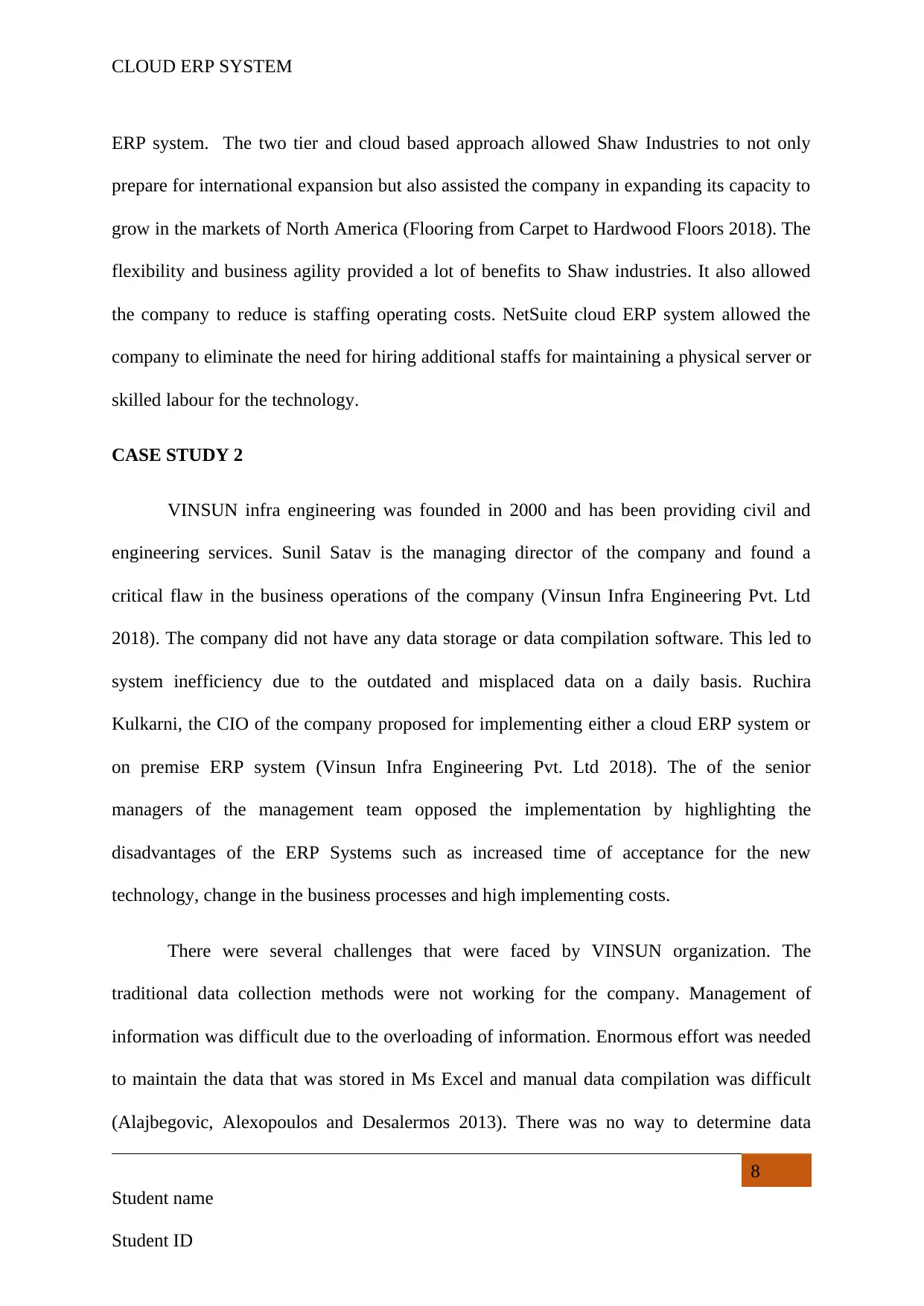
CLOUD ERP SYSTEM
ERP system. The two tier and cloud based approach allowed Shaw Industries to not only
prepare for international expansion but also assisted the company in expanding its capacity to
grow in the markets of North America (Flooring from Carpet to Hardwood Floors 2018). The
flexibility and business agility provided a lot of benefits to Shaw industries. It also allowed
the company to reduce is staffing operating costs. NetSuite cloud ERP system allowed the
company to eliminate the need for hiring additional staffs for maintaining a physical server or
skilled labour for the technology.
CASE STUDY 2
VINSUN infra engineering was founded in 2000 and has been providing civil and
engineering services. Sunil Satav is the managing director of the company and found a
critical flaw in the business operations of the company (Vinsun Infra Engineering Pvt. Ltd
2018). The company did not have any data storage or data compilation software. This led to
system inefficiency due to the outdated and misplaced data on a daily basis. Ruchira
Kulkarni, the CIO of the company proposed for implementing either a cloud ERP system or
on premise ERP system (Vinsun Infra Engineering Pvt. Ltd 2018). The of the senior
managers of the management team opposed the implementation by highlighting the
disadvantages of the ERP Systems such as increased time of acceptance for the new
technology, change in the business processes and high implementing costs.
There were several challenges that were faced by VINSUN organization. The
traditional data collection methods were not working for the company. Management of
information was difficult due to the overloading of information. Enormous effort was needed
to maintain the data that was stored in Ms Excel and manual data compilation was difficult
(Alajbegovic, Alexopoulos and Desalermos 2013). There was no way to determine data
8
Student name
Student ID
ERP system. The two tier and cloud based approach allowed Shaw Industries to not only
prepare for international expansion but also assisted the company in expanding its capacity to
grow in the markets of North America (Flooring from Carpet to Hardwood Floors 2018). The
flexibility and business agility provided a lot of benefits to Shaw industries. It also allowed
the company to reduce is staffing operating costs. NetSuite cloud ERP system allowed the
company to eliminate the need for hiring additional staffs for maintaining a physical server or
skilled labour for the technology.
CASE STUDY 2
VINSUN infra engineering was founded in 2000 and has been providing civil and
engineering services. Sunil Satav is the managing director of the company and found a
critical flaw in the business operations of the company (Vinsun Infra Engineering Pvt. Ltd
2018). The company did not have any data storage or data compilation software. This led to
system inefficiency due to the outdated and misplaced data on a daily basis. Ruchira
Kulkarni, the CIO of the company proposed for implementing either a cloud ERP system or
on premise ERP system (Vinsun Infra Engineering Pvt. Ltd 2018). The of the senior
managers of the management team opposed the implementation by highlighting the
disadvantages of the ERP Systems such as increased time of acceptance for the new
technology, change in the business processes and high implementing costs.
There were several challenges that were faced by VINSUN organization. The
traditional data collection methods were not working for the company. Management of
information was difficult due to the overloading of information. Enormous effort was needed
to maintain the data that was stored in Ms Excel and manual data compilation was difficult
(Alajbegovic, Alexopoulos and Desalermos 2013). There was no way to determine data
8
Student name
Student ID
⊘ This is a preview!⊘
Do you want full access?
Subscribe today to unlock all pages.

Trusted by 1+ million students worldwide
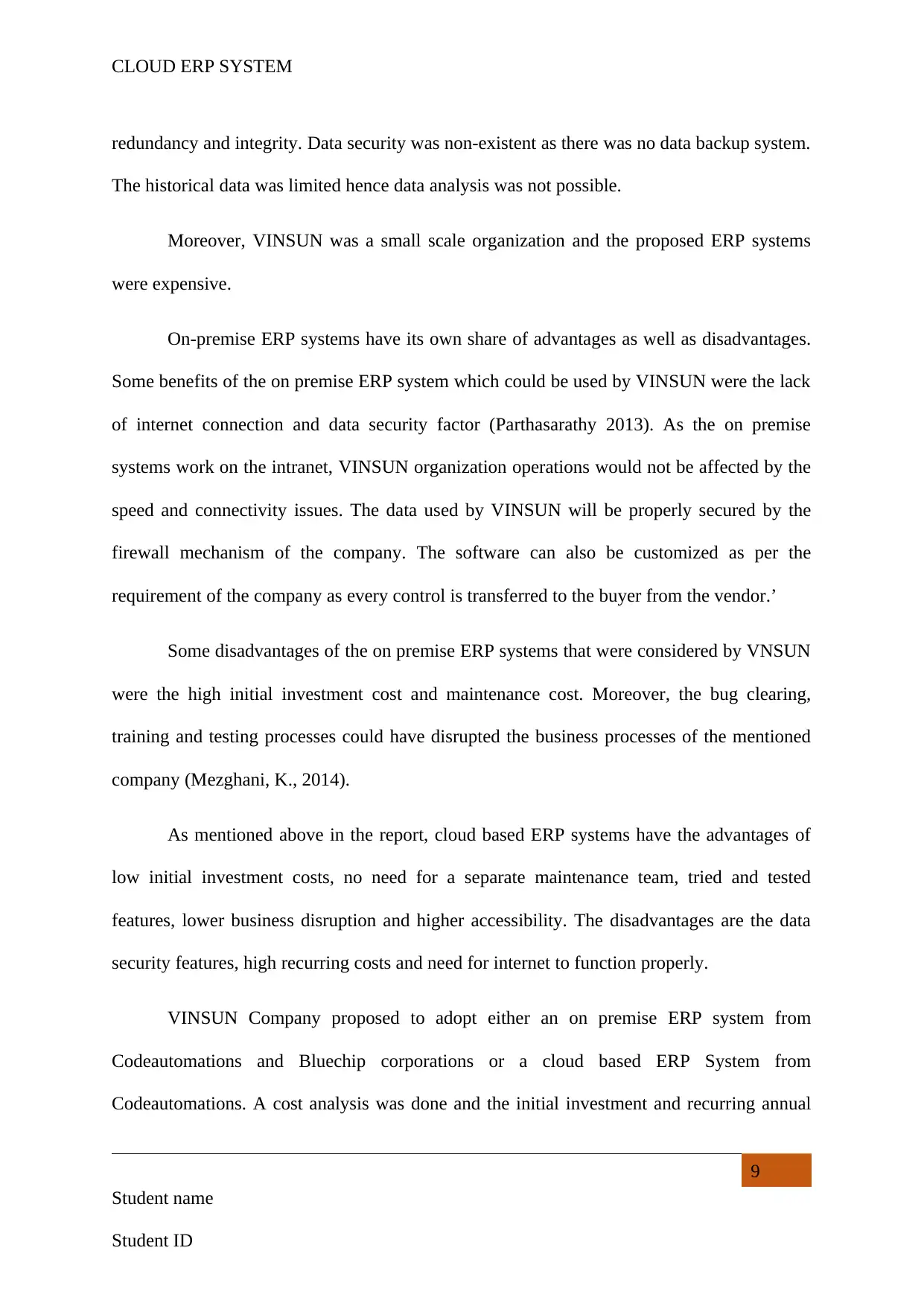
CLOUD ERP SYSTEM
redundancy and integrity. Data security was non-existent as there was no data backup system.
The historical data was limited hence data analysis was not possible.
Moreover, VINSUN was a small scale organization and the proposed ERP systems
were expensive.
On-premise ERP systems have its own share of advantages as well as disadvantages.
Some benefits of the on premise ERP system which could be used by VINSUN were the lack
of internet connection and data security factor (Parthasarathy 2013). As the on premise
systems work on the intranet, VINSUN organization operations would not be affected by the
speed and connectivity issues. The data used by VINSUN will be properly secured by the
firewall mechanism of the company. The software can also be customized as per the
requirement of the company as every control is transferred to the buyer from the vendor.’
Some disadvantages of the on premise ERP systems that were considered by VNSUN
were the high initial investment cost and maintenance cost. Moreover, the bug clearing,
training and testing processes could have disrupted the business processes of the mentioned
company (Mezghani, K., 2014).
As mentioned above in the report, cloud based ERP systems have the advantages of
low initial investment costs, no need for a separate maintenance team, tried and tested
features, lower business disruption and higher accessibility. The disadvantages are the data
security features, high recurring costs and need for internet to function properly.
VINSUN Company proposed to adopt either an on premise ERP system from
Codeautomations and Bluechip corporations or a cloud based ERP System from
Codeautomations. A cost analysis was done and the initial investment and recurring annual
9
Student name
Student ID
redundancy and integrity. Data security was non-existent as there was no data backup system.
The historical data was limited hence data analysis was not possible.
Moreover, VINSUN was a small scale organization and the proposed ERP systems
were expensive.
On-premise ERP systems have its own share of advantages as well as disadvantages.
Some benefits of the on premise ERP system which could be used by VINSUN were the lack
of internet connection and data security factor (Parthasarathy 2013). As the on premise
systems work on the intranet, VINSUN organization operations would not be affected by the
speed and connectivity issues. The data used by VINSUN will be properly secured by the
firewall mechanism of the company. The software can also be customized as per the
requirement of the company as every control is transferred to the buyer from the vendor.’
Some disadvantages of the on premise ERP systems that were considered by VNSUN
were the high initial investment cost and maintenance cost. Moreover, the bug clearing,
training and testing processes could have disrupted the business processes of the mentioned
company (Mezghani, K., 2014).
As mentioned above in the report, cloud based ERP systems have the advantages of
low initial investment costs, no need for a separate maintenance team, tried and tested
features, lower business disruption and higher accessibility. The disadvantages are the data
security features, high recurring costs and need for internet to function properly.
VINSUN Company proposed to adopt either an on premise ERP system from
Codeautomations and Bluechip corporations or a cloud based ERP System from
Codeautomations. A cost analysis was done and the initial investment and recurring annual
9
Student name
Student ID
Paraphrase This Document
Need a fresh take? Get an instant paraphrase of this document with our AI Paraphraser
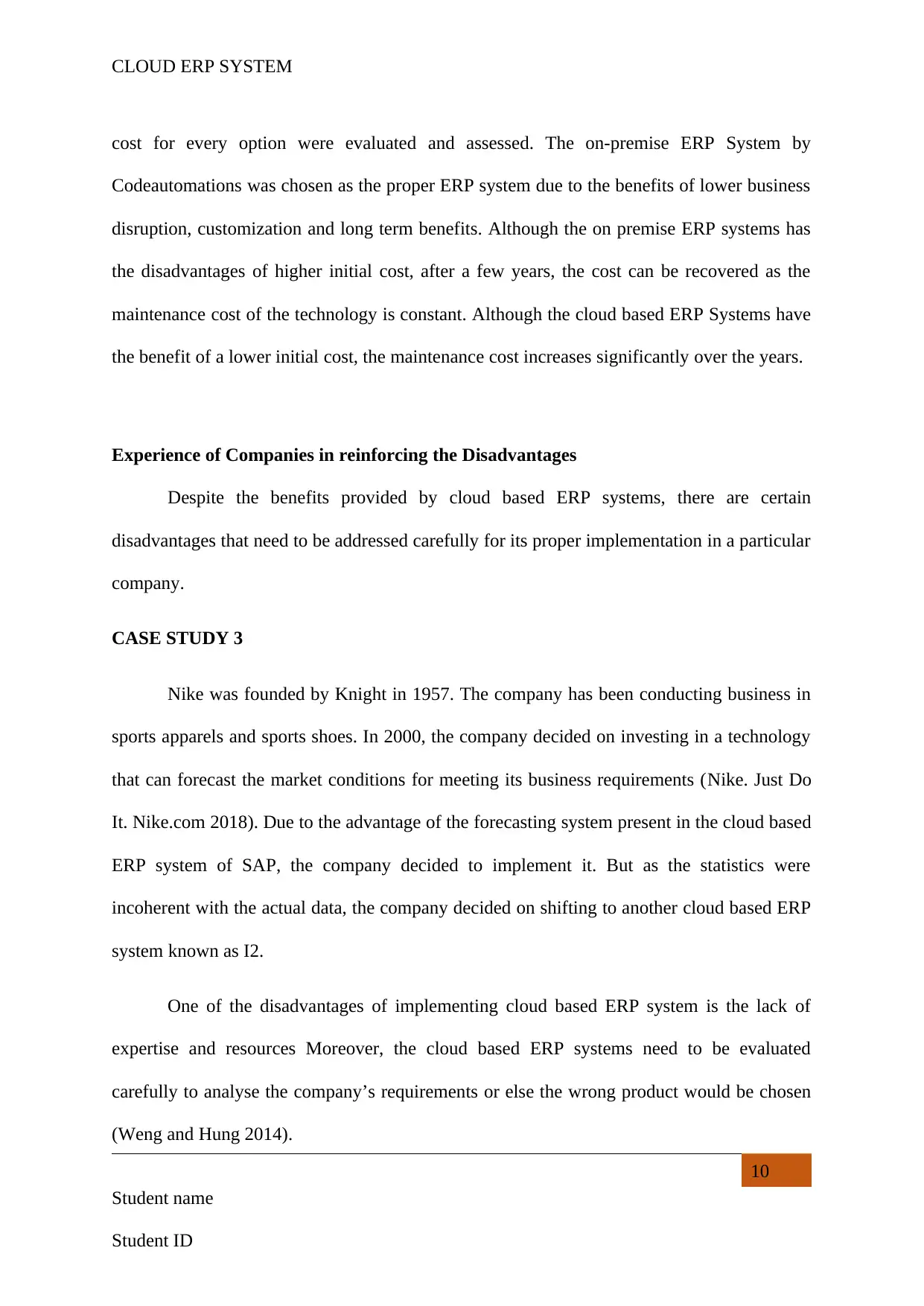
CLOUD ERP SYSTEM
cost for every option were evaluated and assessed. The on-premise ERP System by
Codeautomations was chosen as the proper ERP system due to the benefits of lower business
disruption, customization and long term benefits. Although the on premise ERP systems has
the disadvantages of higher initial cost, after a few years, the cost can be recovered as the
maintenance cost of the technology is constant. Although the cloud based ERP Systems have
the benefit of a lower initial cost, the maintenance cost increases significantly over the years.
Experience of Companies in reinforcing the Disadvantages
Despite the benefits provided by cloud based ERP systems, there are certain
disadvantages that need to be addressed carefully for its proper implementation in a particular
company.
CASE STUDY 3
Nike was founded by Knight in 1957. The company has been conducting business in
sports apparels and sports shoes. In 2000, the company decided on investing in a technology
that can forecast the market conditions for meeting its business requirements (Nike. Just Do
It. Nike.com 2018). Due to the advantage of the forecasting system present in the cloud based
ERP system of SAP, the company decided to implement it. But as the statistics were
incoherent with the actual data, the company decided on shifting to another cloud based ERP
system known as I2.
One of the disadvantages of implementing cloud based ERP system is the lack of
expertise and resources Moreover, the cloud based ERP systems need to be evaluated
carefully to analyse the company’s requirements or else the wrong product would be chosen
(Weng and Hung 2014).
10
Student name
Student ID
cost for every option were evaluated and assessed. The on-premise ERP System by
Codeautomations was chosen as the proper ERP system due to the benefits of lower business
disruption, customization and long term benefits. Although the on premise ERP systems has
the disadvantages of higher initial cost, after a few years, the cost can be recovered as the
maintenance cost of the technology is constant. Although the cloud based ERP Systems have
the benefit of a lower initial cost, the maintenance cost increases significantly over the years.
Experience of Companies in reinforcing the Disadvantages
Despite the benefits provided by cloud based ERP systems, there are certain
disadvantages that need to be addressed carefully for its proper implementation in a particular
company.
CASE STUDY 3
Nike was founded by Knight in 1957. The company has been conducting business in
sports apparels and sports shoes. In 2000, the company decided on investing in a technology
that can forecast the market conditions for meeting its business requirements (Nike. Just Do
It. Nike.com 2018). Due to the advantage of the forecasting system present in the cloud based
ERP system of SAP, the company decided to implement it. But as the statistics were
incoherent with the actual data, the company decided on shifting to another cloud based ERP
system known as I2.
One of the disadvantages of implementing cloud based ERP system is the lack of
expertise and resources Moreover, the cloud based ERP systems need to be evaluated
carefully to analyse the company’s requirements or else the wrong product would be chosen
(Weng and Hung 2014).
10
Student name
Student ID
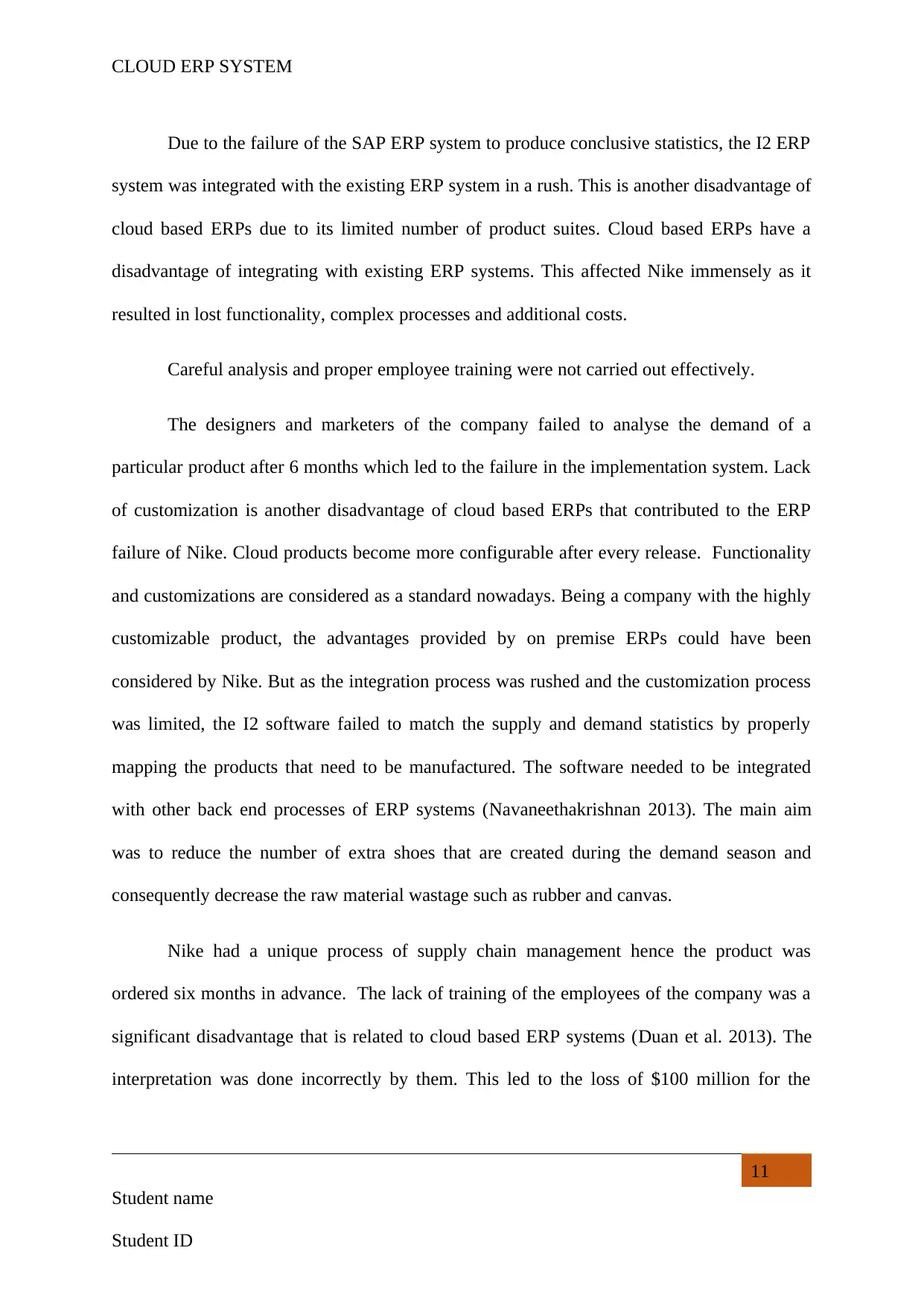
CLOUD ERP SYSTEM
Due to the failure of the SAP ERP system to produce conclusive statistics, the I2 ERP
system was integrated with the existing ERP system in a rush. This is another disadvantage of
cloud based ERPs due to its limited number of product suites. Cloud based ERPs have a
disadvantage of integrating with existing ERP systems. This affected Nike immensely as it
resulted in lost functionality, complex processes and additional costs.
Careful analysis and proper employee training were not carried out effectively.
The designers and marketers of the company failed to analyse the demand of a
particular product after 6 months which led to the failure in the implementation system. Lack
of customization is another disadvantage of cloud based ERPs that contributed to the ERP
failure of Nike. Cloud products become more configurable after every release. Functionality
and customizations are considered as a standard nowadays. Being a company with the highly
customizable product, the advantages provided by on premise ERPs could have been
considered by Nike. But as the integration process was rushed and the customization process
was limited, the I2 software failed to match the supply and demand statistics by properly
mapping the products that need to be manufactured. The software needed to be integrated
with other back end processes of ERP systems (Navaneethakrishnan 2013). The main aim
was to reduce the number of extra shoes that are created during the demand season and
consequently decrease the raw material wastage such as rubber and canvas.
Nike had a unique process of supply chain management hence the product was
ordered six months in advance. The lack of training of the employees of the company was a
significant disadvantage that is related to cloud based ERP systems (Duan et al. 2013). The
interpretation was done incorrectly by them. This led to the loss of $100 million for the
11
Student name
Student ID
Due to the failure of the SAP ERP system to produce conclusive statistics, the I2 ERP
system was integrated with the existing ERP system in a rush. This is another disadvantage of
cloud based ERPs due to its limited number of product suites. Cloud based ERPs have a
disadvantage of integrating with existing ERP systems. This affected Nike immensely as it
resulted in lost functionality, complex processes and additional costs.
Careful analysis and proper employee training were not carried out effectively.
The designers and marketers of the company failed to analyse the demand of a
particular product after 6 months which led to the failure in the implementation system. Lack
of customization is another disadvantage of cloud based ERPs that contributed to the ERP
failure of Nike. Cloud products become more configurable after every release. Functionality
and customizations are considered as a standard nowadays. Being a company with the highly
customizable product, the advantages provided by on premise ERPs could have been
considered by Nike. But as the integration process was rushed and the customization process
was limited, the I2 software failed to match the supply and demand statistics by properly
mapping the products that need to be manufactured. The software needed to be integrated
with other back end processes of ERP systems (Navaneethakrishnan 2013). The main aim
was to reduce the number of extra shoes that are created during the demand season and
consequently decrease the raw material wastage such as rubber and canvas.
Nike had a unique process of supply chain management hence the product was
ordered six months in advance. The lack of training of the employees of the company was a
significant disadvantage that is related to cloud based ERP systems (Duan et al. 2013). The
interpretation was done incorrectly by them. This led to the loss of $100 million for the
11
Student name
Student ID
⊘ This is a preview!⊘
Do you want full access?
Subscribe today to unlock all pages.

Trusted by 1+ million students worldwide
1 out of 19
Related Documents
Your All-in-One AI-Powered Toolkit for Academic Success.
+13062052269
info@desklib.com
Available 24*7 on WhatsApp / Email
![[object Object]](/_next/static/media/star-bottom.7253800d.svg)
Unlock your academic potential
Copyright © 2020–2025 A2Z Services. All Rights Reserved. Developed and managed by ZUCOL.





